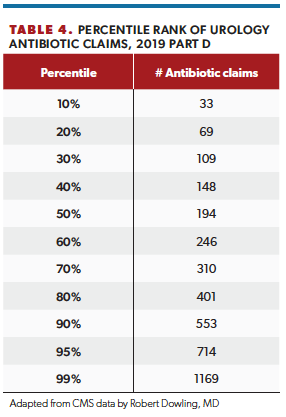Publication
Article
Urology Times Journal
Part D data reveal how urologists are prescribing antibiotics
Author(s):
Urologists prescribe at rates higher than many other specialties.
Robert A. Dowling, MD

According to the Centers for Disease Control and Prevention, antibiotic resistance is an urgent public health problem that is responsible for over 2.8 million infections and more than 35,000 deaths annually in the United States.1 Antibiotic prescriptions per capita vary widely across the US, and the misuse of antibiotics has undoubtedly contributed to the growing problem of resistance. We know that sepsis after prostate biopsy is more common in patients with a history of previous antibiotic use and is frequently due to resistant organisms. In this the second in a series of articles based on Medicare Part D prescription data, I will describe the Part D antibiotic prescribing habits/norms/benchmarks of urologists.
The Centers for Medicare & Medicaid Services recently updated its information on prescription claims for Medicare beneficiaries enrolled in Part D (Prescription Drug Coverage) aggregated by provider and drug to include 2019 data.2 (About two-thirds of Medicare beneficiaries are enrolled in Part D drug plans.) A related data set includes summary information on opioid and antibiotic prescribing rates. These data sets suppress information on providers or drugs with 10 or fewer claims because of the small chance of identifying a patient, but contain enough information to serve as good benchmarks in my opinion.

A total of 1.5 billion Part D claims involving 1.24 million Medicare providers were submitted in 2019, including 60 million antibiotic claims. The antibiotic prescribing rate can be defined as the number of antibiotic claims/all Part D claims (expressed as %), and averages 4.0% for all specialties. The specialties with the highest antibiotic prescribing rates are dental specialties (54%), plastic and reconstructive surgery (30%), infectious disease (23%), and colorectal surgery (22%). The overall antibiotic prescribing rate for urology in Part D was 18%. A total of 117 unique antibiotic drugs were prescribed in 2019; the top 20 drugs prescribed among all providers are listed in Table 1.

In 2019, 8815 urologists prescribed 2.5 million prescriptions (5.4%) of 46 types of antibiotics, the highest ranked non–primary care specialty (Table 2). The most common drugs prescribed by urologists in 2019 to Part D beneficiaries were ciprofloxacin hcl, sulfamethoxazole/trimethoprim, cephalexin, and nitrofurantoin (Table 3). Unlike for opioids—of which urologists tend to have 1 or 2 favorite drugs—most urologists prescribed 3 to 7 different antibiotics in 2019.

How do your habits compare to those of other urologists? To view your data, go to https://bit.ly/3tS5L86, search for your national provider identifier or name, and scroll to the column marked [Antbtc_Tot_Clms]. Compare your number of antibiotic claims to the benchmarks in Table 4. For example, if you are associated with 500 antibiotic claims, you prescribed more antibiotics than 85% of your urology peers in this data set. Keep in mind, although Medicare beneficiaries typically comprise a significant fraction of a urology practice, your prescribing habits reflected here may not be generalizable to all patients.

How do antibiotics contribute to the cost of prescription medicines in the Part D program? Antibiotics are relatively inexpensive drugs, which may contribute to the potential for overuse. The total cost for antibiotic claims in 2019 was $1.5 billion, a small fraction of total Part D spending. Urology antibiotic claims totaled only $32 million. There is some variation in cost among the class (nitrofurantoin and doxycycline are the most expensive), all of which are readily available as generic drugs (Table 3).
The bottom line and why it matters
Urologists prescribe antibiotics to Part D beneficiaries in higher quantities and rates than most other specialists, including surgical specialists; it is the nature of the specialty. It is well established that antibiotic overuse and misuse (for example, inappropriate duration) contribute to community resistance, and urologists are positioned to be important stewards of antibiotic prescribing. Key opportunities in urology include limiting antibiotic prophylaxis to 24 hours. Clinical guidelines and best practice statements for the appropriate indications, drugs, and durations are available from specialty societies including the American Urological Association3 and the Infectious Diseases Society of America (https://bit.ly/3K5PvFt). Medicare Part D data on each individual prescriber are readily available to urologists, patients, and the public and can be used to compare your prescribing habits against national and specialty benchmarks.
References
1. Antibiotic prescribing and use. Centers for Disease Control and Prevention. Updated October 7, 2021. Accessed April 21, 2022. https://bit.ly/3xRACUV
2. Medicare Part D prescribers – by provider and drug. Centers for Medicare & Medicaid Services. Updated August 31, 2021. Accessed April 21, 2022. https://bit.ly/3qO8wFE
3. Urologic procedures and antimicrobial prophylaxis (2019). American Urological Association. June 2019. Accessed April 21, 2022. https://bit.ly/3rLDWgb

Newsletter
Stay current with the latest urology news and practice-changing insights — sign up now for the essential updates every urologist needs.




























